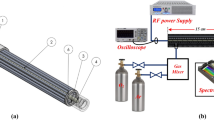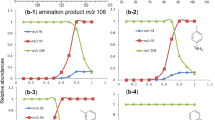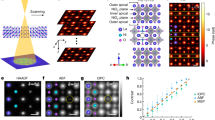Abstract
THE Vegard – Kaplan A 3∑ − X 1∑ bands of nitrogen (N2), some members of which are thought to occur in the spectrum of the upper air, usually require rather special conditions for production in the laboratory1. Wulf and Melvin2 and Janin3 have, however, shown that they are emitted readily from discharges through pure nitrogen in conventional ozonizers. As such tubes are somewhat inconvenient to set up and outgas, we have sought to modify them and have found the simple form shown diagrammatically in Fig. 1 quite effective. The left-hand section is a piece of ‘Pyrex’ tube, connected to a pumping train and sodium azide nitrogen generator through a trap cooled in liquid oxygen. The central section consists of the same tube flattened to a roughly circular disk 7 cm. in diameter, with its plane normal to the paper, and an internal clearance of 2–6 mm. The right-hand section is a ‘Pyrex’-quartz graded seal with a flat quartz end. A Tesla discharge is passed through the central section between disk electrodes (A,A′) pressed against its outer faces, and the spectrum observed through the quartz window. The discharge is a shower of small sparks, as described by Wulf and Melvin.
This is a preview of subscription content, access via your institution
Access options
Subscribe to this journal
Receive 51 print issues and online access
$199.00 per year
only $3.90 per issue
Buy this article
- Purchase on SpringerLink
- Instant access to full article PDF
Prices may be subject to local taxes which are calculated during checkout
Similar content being viewed by others
References
Pearse, R. W. B., and Gaydon, A. C., “Identification of Molecular Spectra” (Chapman and Hall, London, 1950). Herman, R., and Herman, L., J. Phys., 10, 132 (1949).
Wulf, O. R., and Melvin, E., Phys. Rev., 55, 687 (1939).
Janin, J., Thesis, Paris (1946).
Jenkins, H. G., Bowtell, J. N., and Strong, R. W., Nature, 163, 401 (1949).
Emeléus, K. G., Sayers, N. D., and Bailey, R. A., Nature, 166, 656 (1950). Sayers, N. D., and Emeléus, K. G., Pros. Phys. Soc., 65 A, 219 (1952).
Bernard, R., C.R. Acad. Sci., Paris, 200, 2074 (1935).
Author information
Authors and Affiliations
Rights and permissions
About this article
Cite this article
SAYERS, N., TAYLOR, G. & EMELÉUS, K. Laboratory Production of the Vegard – Kaplan Bands. Nature 175, 254 (1955). https://doi.org/10.1038/175254a0
Issue date:
DOI: https://doi.org/10.1038/175254a0



